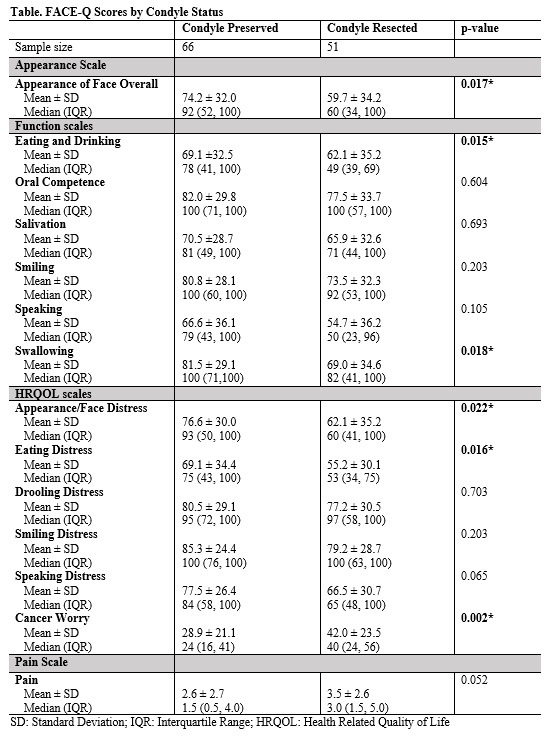Patient Reported Outcomes After Condyle Resection and Reconstruction of Lateral Mandible Defects: A Preliminary Analysis Using the FACE-Q
Kevin Zhang*1, Minji Kim1, Zack Cohen1, Jonas Nelson1, Jennifer Cracchiolo2, Farooq Shahzad1, Evan Matros1, Robert Allen Jr.1
1Plastic and Reconstructive Surgery, Memorial Sloan Kettering Cancer Center, New York, NY; 2Head and Neck Oncology Surgery Service, Memorial Sloan Kettering Cancer Center, New York, NY
Tumor involvement of the posterior mandible often necessitates resection of the condyle and associated soft tissue elements, thereby increasing complexity of the ensuing reconstruction and rehabilitation. While previous studies have evaluated postoperative morbidity and functional status, this study compares FACE-Q scores of patients whose condyles were sacrificed versus those whose condyles were preserved prior to free flap reconstruction of lateral mandibulectomy defects.
Patients who underwent lateral mandibulectomy and free flap reconstruction between 2000-2021 and completed at least one postoperative FACE-Q were retrospectively reviewed. Cohorts were divided based on whether the mandibular condyle was included in the resection. Baseline patient and treatment characteristics were compared. FACE-Q responses were divided into appearance, functional, and stress domains scored from 0-100, where higher scores represent better outcomes.
117 patients underwent free flap reconstruction of a lateral mandibulectomy defect and completed a FACE-Q survey; of these, 51 patients had condyle resection, and 66 patients had condyle preservation. Patients within the condyle preserved group were more likely to have received a bony free flap, and those in the condyle resected group were more likely to have received a soft tissue flap (p=0.001). Condyle preserved patients reported significantly greater satisfaction with their overall appearance score (p=0.017), swallowing (p=0.018), and eating and drinking (p=0.015) function. Condyle preserved patients also reported significantly greater satisfaction with their appearance distress (p=0.022) and eating and drinking distress (p=0.016). Condyle resected patients reported significantly better cancer worry distress (p=0.002).
Patients who had their condyles and temporomandibular joint preserved reported greater post-reconstructive satisfaction in multiple domains. Studies with larger cohorts and longer follow-up interval could provide valuable information for surgeons when counseling patients on expected outcomes after mandible resection.
Back to 2023 Abstracts


